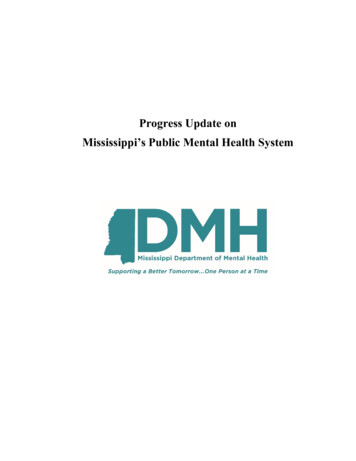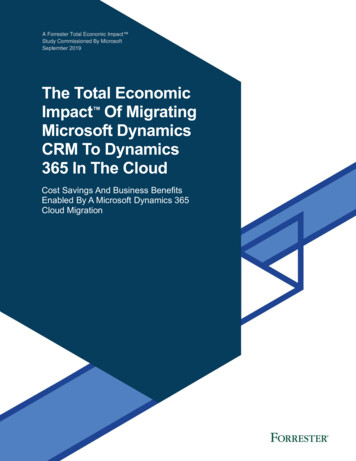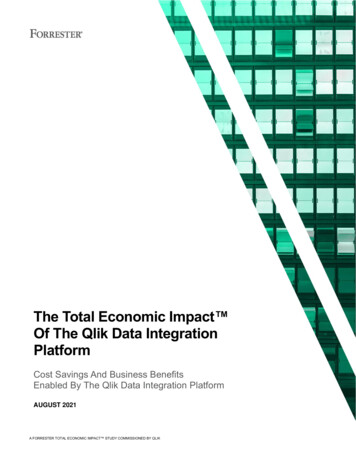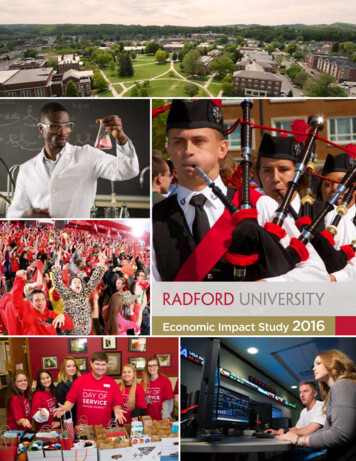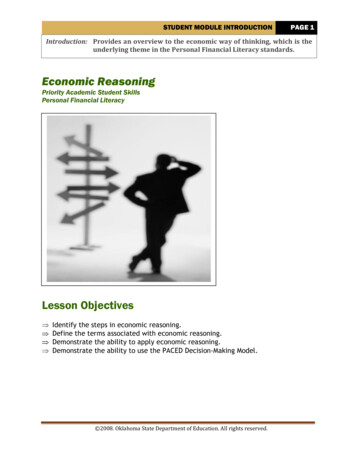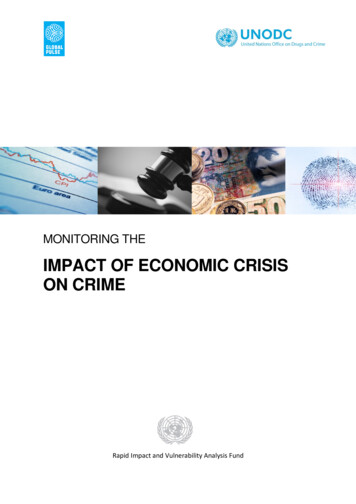
Transcription
MONITORING THEIMPACT OF ECONOMIC CRISISCRISISON CRIMERapid Impact and Vulnerability Analysis Fund
UNITED NATIONS OFFICE ON DRUGS AND CRIMEViennaAcknowledgementsThis report was prepared by UNODC Statistics and Surveys Section (SASS)Research coordination, analysis, and report preparation:Steven Malby (SASS)Philip Davis (SASS)Data collection and methodological development:Wilfried de Wever (Consultant)Egon van den Broek (Consultant)Renata Rizzi (Consultant)Catherine Pysden (SASS)SupervisionSandeep Chawla (Director, Division of Policy Analysis and Public Affairs) and Angela Me (Chief, SASS)The preparation of this report would not have been possible without the data and information provided by thefollowing individuals:Gervasio Landivar (Ministry of Justice, Argentina)Luciane Patricio Braga de Moraes (Ministry of Justice, Brazil)Kwing Hung (Department of Justice, Canada)Maria Isabal Gutierrez (Instituto CISALVA, Colombia)Edgardo Amaya (Ministry of Public Security, El Salvador)Courtney Brown (Ministry of National Security, Jamaica)Eva Belli (Ministry of Interior, Italy)Brigita Lasenberga (State Police, Latvia)Guillaume Naigee (National Statistical Institute, Mauritius)Adrian Franco Barrios (National Statistical Institute, Mexico)Harry Smeets (City of Amsterdam, The Netherlands)Edgar Guerreo (National Statistical Institute, Mexico)Myrna De Persia-Medina (National Police Commission, The Philippines)Yolanda Lira (National Police Commission, The Philippines)Beata Gruszczynska (Ministry of Justice, Poland)Teerawut Kingwan (Royal Thai Police, Thailand)Fabricio Fagundez (National Police, Uruguay)DisclaimersThis report has not been formally edited. The contents of this publication do not necessarily reflect the viewsor policies of UNODC or contributory organizations and neither do they imply any endorsement.The designations employed and the presentation of material in this publication do not imply the expression ofany opinion on the part of UNODC concerning the legal status of any country, territory or city or its authorities,or concerning the delimitation of its frontiers or boundaries.2 P a g e
ContentsExecutive Summary . 4Background: Crime and Economic Factors . 8Data Collection and Analysis . 10Measuring crime . 10Measuring economies . 14Visualizing economic crisis and its relationship with crime . 15Results from data visualization . 15Visualizing economic crisis . 16Visualizing the impact on crime . 19Conclusions from data visualization . 23Statistical analysis of crime and economy time series. 24Results from statistical analysis . 24Selection of the analytical method . 26Comparing results from visualization and statistical modelling . 27Conclusions from ARIMA modelling . 29Forecasting crime trends . 30Results of crime forecasting. 30Assessing the impact of economic predictors . 34Conclusions and next steps . 36Key findings . 36Annex 1 – Crime series metadata. 39Annex 2 – Detailed results of statistical modelling . 43Annex 3 – Statistical methodology . 45Annex 4 – Best-fit ARIMA models for each context. 473 P a g e
Monitoring the Impact of Economic Crisis on CrimeExecutive SummaryWithin the context of the United Nations Global Pulse initiative on monitoring the impact of crisis onvulnerable populations, this report presents the results of a unique cross-national analysis that aims toinvestigate the possible effects of economic stress on crime. Using police-recorded crime data for the crimes ofintentional homicide, robbery and motor vehicle theft, from fifteen country or city contexts across the world,the analysis examines in particular the period of global financial crisis in 2008/2009. As economic crisis mayoccur over a relatively short timescale, this period, as well as – in many cases – up to 20 years previously, areexamined using high frequency (monthly) crime and economic data.The report finds that, whether in times of economic crisis or non-crisis, economic factors play an importantrole in the evolution of crime trends. Out of a total of fifteen countries examined, statistical modellingidentifies an economic predictor for at least one crime type in twelve countries (80 percent), suggesting someoverall association between economic changes and crime.In eleven of the fifteen countries examined, economic indicators showed significant changes suggestive of aperiod of economic crisis in 2008/2009. Both visual inspection of data series and statistical modelling suggestthat in eight of these eleven ‘crisis’ countries, changes in economic factors were associated with changes incrime, leading to identifiable crime ‘peaks’ during the time of crisis. Violent property crime types such asrobbery appeared most affected during times of crisis, with up to two-fold increases in some contexts during aperiod of economic stress. However, in some contexts, increases in homicide and motor vehicle theft werealso observed. These findings are consistent with criminal motivation theory, which suggests that economicstress may increase the incentive for individuals to engage in illicit behaviours. In no case where it was difficultto discern a peak in crime was any decrease in crime observed. As such, the available data do not support acriminal opportunity theory that decreased levels of production and consumption may reduce some crimetypes, such as property crime, through the generation of fewer potential crime targets.CountryArgentinaBrazilGeographic unitEconomic crisis(on visualization)(on visualization)Economic indicator identified as predictor of crime change(by statistical model) (in 2002)-Share price indexNationaln/aShare price index, unemployment rateRio de Janeiro Robbery, motor vehicletheftTreasury bill rateBuenos AiresSao PauloCanadaCrime type affected byeconomic crisisNationalHomicide, robberyMale unemployment rate, currency per SDR n/aTreasury bill rate, unemployment rate, share price index,deposit rateRobbery-Costa RicaNational El SalvadorNational Homicide- Robbery, motor vehicletheftReal incomeItalyNationalJamaicaNational Homicide, robbery-LatviaNational -Youth unemployment rateMauritiusNational -Real income, currency per SDR Robbery, motor vehicletheftMale unemployment--Deposit rate, share al--Treasury bill rateThailandNational Motor vehicle theftUnemployment rate, real incomeTrinidad andTobagoNational -Real income, lending rateUruguayMontevideo--GDPFor each country/city a number of individual crimes and economic variables were analyzed. Across allcombinations, a significant association between an economic factor and a crime type was identified in around
47 percent of individual combinations. For each country, different combinations of crime and economicpredictors proved to be significant. Among the two methods used to analyze the links between economic andcrime factors (visualization and statistical modelling), different combinations of factors were found to besignificant and in five cases the two methods identified the same variables. Three out of these five casesrepresented city contexts rather than national contexts. This may indicate that associations between crimeand economic factors are best examined at the level of the smallest possible geographic unit.Where an association between one or more economic variables and crime outcomes were identified bystatistical modelling, the model frequently indicated a lag time between changes in the economic variable andresultant impact on crime levels. The average lag time in the contexts examined was around four and halfmonths. In this respect, it should be noted that the relationship between crime and economy is not necessarilyuni-directional. Whilst there are theoretical arguments for why changes in economic conditions may affectcrime, it could also be the case that crime itself impacts upon economic and developmental outcomes, such aswhen very high violent crime levels dissuade investment. During the statistical modelling process, crime wasset as the ‘outcome’ variable and economic data as the ‘independent’ variable. As such, the model was notused to investigate the converse relationship – whether changes in crime could also help explain economicoutcomes.The statistical model proved successful at forecasting possible changes in crime for a number of crime typecountry/city contexts. Forecasting for a period of three months using a statistical model with economicpredictors proved possible with reasonable accuracy (both in terms of direction and magnitude) in a numberof different contexts, including both in times of crisis and non-crisis. Many of the forecasts are sufficientlyaccurate to be of value in a practical scenario. Crime forecasts sometimes led, however, to underestimation ofcrime changes, suggesting that modelling of crime changes is not optimal when based on economic predictorsalone. Indeed, economic changes are not the only factor that may impact levels of crime. The presence ofyouth gangs, weapons availability, the availability and level of protection of potential targets, drug and alcoholconsumption and the effectiveness of law enforcement activity all play a significant role in enabling orrestraining overall crime levels.Crime forecasting using statistical 006Fitted y in h the challenges remain significant, this report demonstrates that – with comparatively few resources– a lot may be learned from the application of analytical techniques to existing data. Continuedmethodological development, including the creation of an online data reporting ‘portal’, as well as thestrengthening of exchange of information and experience, between countries, has the potential to lay thefoundation of a strong ‘early-warning’ system. The analysis reported here does not prove the existence ofrelationships between economic factors and crime. It does provide strong indications that certain associationsare present, and that much may be gained from further investigation. If the impact of economic stress oncrime trends can be further understood, and even forecasted in the short-term, then there is the potential togain much through policy development and crime prevention action.5 P a g e
IntroductionInitial work within the context of the United Nations Global Pulse initiative warns that world leaders“must watch for indications of increased social tensions, crime and violent outbreaks incommunities” as the financial crisis hits vulnerable populations worldwide.1 This is based on thepremise that crime victims and offenders represent vulnerable groups that are likely to increase insize in times of crisis.If Member States and the international community are to meet this challenge, there is a need fortimely, accurate, and relevant cross-national information on crime levels and trends.With the support of the Rapid Impact and Vulnerability Analysis Fund (RIVAF), the United NationsOffice on Drugs and Crime (UNODC) was tasked with providing the core data and accompanyinganalysis that could enable the early identification of potentially increasing crime trends.The initiative does not begin in a knowledge vacuum. A significant body of work exists on therelationship between economic indicators and crime and violence. This work tends, however, toconsist either of national ‘in-house’ research carried out by government ministries that examines thesituation in just one country2, or to exist in the academic literature.3 Academic work, whilst it mayhave some cross-national focus, is frequently limited to analysis of publicly available or mediasupplied information, and may not directly engage governments in the process of data collectionand analysis.UNODC has established substantive expertise in the area of crime prevention, including throughwork on the promotion and implementation of the United Nations Guidelines for the Prevention ofCrime.4 It also acts as the hub for crime and criminal justice statistics within the United Nationssystem. Through its ‘United Nations Survey of Crime Trends and Operations of Criminal JusticeSystems’ (UN-CTS), UNODC has collected data from Member States since the 1970s. Data collectedcomprise police records by offence type, including both ‘conventional crimes’ such as intentionalhomicide, robbery, theft and burglary, and ‘complex crimes’, such as corruption and trafficking inpersons.5Whilst existing UNODC knowledge and capacity is well placed to meet the challenges ofunderstanding the complex relationship between economic factors and crime, in order to meet thedata and policy needs of Global Pulse, it became necessary to further expand and tailor existingUNODC data collection systems. In particular, in order to detect and respond to rapidly changingsocio-economic situations, the timeliness and periodicity of data collection had to be increased, andthe capacity for time series analysis in light of relevant economic data introduced.This report describes findings from high frequency (monthly) crime and economic data available forfifteen countries – Argentina, Brazil, Canada, Costa Rica, El Salvador, Italy, Jamaica, Latvia, Mauritius,Mexico, Philippines, Poland, Thailand, Trinidad and Tobago, and Uruguay. The majority of data12345Voices of the vulnerable: The economic crisis from the ground up. Available athttp://www.voicesofthevulnerable.netSee for example, United Kingdom Home Office, Modelling and predicting property crime trends in Englandand Wales. Available at: or a recent review of the state of the literature, see Congressional Research Service, Economic Downturnsand Crime, 28 July 2009.Economic and Social Council resolution 2002/13, annex.See ime-Monitoring-Surveys.html?ref menuside6 P a g e
considered are at national level although data for four cities – Buenos Aires, Montevideo, São Paulo,and Rio de Janeiro – are also examined. These countries and cities were chosen based on a numberof factors including overall crime levels, experience of economic downturn during the 2008/2009financial crisis, the ability to supply high frequency police-recorded crime data, and broadgeographic distribution.UNODC is extremely grateful for the constructive engagement of those countries that have provideddata upon request, for the purposes of this analysis. Throughout the Global Pulse project onmeasuring the impact of the economic crisis on crime, a core group of countries consisting of thoselisted above, in addition to the CISALVA Institute in Colombia and the Netherlands, have beeninstrumental in the process of exchange of ideas, experience and knowledge. In particular, aninformal expert meeting on the impact of economic crisis on crime held in Vienna from 1-2November 2010 provided an opportunity for exchanging country experience on the perceivedimpact of economic crisis on crime, for reviewing preliminary data analysis carried out by UNODC,and for advising UNODC on the further development of the project.6The aims of the project are twofold: To identify and raise awareness at global, regional and national level of the possible effectsof economic stress on crime; and To work towards a predictive capacity for such effects at country level.The project attempts these aims through the development of an online tool for reporting of highfrequency data and the statistical time series analysis of crime and economic data. In this report,retrospective analysis of time series for up to the last 20 years, often including the 2008/2009 periodof financial crisis, is used to look for possible associations between crime and economic factors.Where prima facie evidence of such an association exists, a statistical model is used to explorewhether knowledge of economic changes can be used to predict possible changes in crime events.In addition to economic variables, changes in a large number of other factors, including theavailability and degree of protection of potential crime targets, presence of youth gangs, drugs andweapons availability, drug and alcohol consumption, willingness to report crime, as well as methodsand capacities for recording crime, may all significantly affect police-recorded crime trends. Inprinciple, statistical modelling would ideally take account of such effects with a view to excluding orcontrolling for them. The analysis presented in this report does not do so as a result of limitations oftime, data handling complexity, and data availability. As such, the statistical analysis should not betaken as a comprehensive model for the underlying factors that may influence crime levels andtrends. Rather, the analysis is an exploratory attempt to consider whether changes in specific crimetypes over time may be associated in some sense with economic changes as at least one componentof underlying factors.6See UNODC, Report of the Informal Expert Meeting on the Impact of Economic Crisis on Crime, ViennaInternational Centre, 1-2 November 20107 P a g e
Background: Crime and Economic FactorsThe proposition contained in the ‘Voices of the vulnerable’ report – that the financial crisis couldlead to ‘increased crime’ – certainly appears to be plausible. Criminal motivation theories, includingstrain theory, propose that illicit behaviours are caused, at least in part, by structurally inducedfrustrations at the gap between aspirations and expectations, and their achievement in practice.Where the financial crisis is manifested through decreased or negative economic growth andwidespread unemployment, large numbers of individuals may suffer severe, and perhaps sudden,reductions in income. This, in turn, has the potential to cause an increase in the proportion of thepopulation with an (arguably) higher motivation to identify illicit solutions to their immediateproblems. Whilst this may appear as a simple explanation for property crime, stress situations arealso the cause of many violent crimes. Unemployed persons may become increasingly intolerant andaggressive, especially in their families. Violence among strangers may also increase in situations inwhich people do not have clear prospects for their future.Whilst unemployment figures are often used as a key indicator for analysis of the effect of economicconditions on crime, official unemployment figures alone cannot provide a complete indicator ofeither the financial crisis itself or levels of population financial stress. They do not always takeaccount, for example, of those employed in the informal sector, those supporting large or extendedfamilies through low-paid formal employment, or those who survive on remittances from workersabroad. Moreover, in addition to loss of employment, the financial crisis may also manifest itselfthrough reduced government social expenditure, increased cost of basic consumer goods, andrestrictions on local credit availability. Any or all of these may result in financial stress for individualsand communities, with no change in official unemployment figures.Nonetheless, due largely to its availability and comparative simplicity, unemployment has beenwidely used in the literature as a proxy for ‘economic activity’ in the investigation of the relationshipbetween economic downturns and criminal events.7 A number of these studies do find smallstatistically significant correlations between unemployment and property crime rates. Thisrelationship tends to hold true more often for property crime than for violent crime types.8However, literature reviews show large disparities in the magnitude of the correlation betweenunemployment and crime, with some studies identifying weak relationships, others a significantrelationship, and still others no relationship between unemployment and crime rates. The reasonsfor this are manifold. First of all, not many people, even facing severe financial problems, may notthink of turning to crime and may even seek more desperate solutions. Increased suicide rates, forexample, are observed at times of crisis.9 Secondly, criminal-opportunity theory suggests that at thesame time as income stress could provide incentives to commit crime, decreased levels of economicproduction and consumption associated with economic slowdown, in addition to increasedconcentrations of (unemployed) persons around potential property crime targets (houses, cars) mayreduce opportunities to commit crime. Proponents of this theory argue that this is the case for bothproperty and violent crime. 1078910See for example, Levitt, S.D., Understanding why crime fell in the 1990s: Four factors that explain thedecline and six that do not, The Journal of Economic Perspectives, vol. 18, no. 1 (2004), pp. 163-190Raphael, S., Winter-Ebmer, R., Journal of Law and Economics, vol. 44, no. 1 (2001), pp. 259-283See for example, Rushing, W.A. Income, unemployment and suicide: an occupational study, TheSociological Quarterly, vol. 9, no.4 (1968), pp. 493-503Cantor, D., Land, K.C., Unemployment and crime rates in the post-World War II United States: A theoreticaland empirical analysis, American Sociological Review, vol. 50, no.3 (1985), pp.317-3328 P a g e
Further criminological factors that may impact on the relationship include the introduction andadoption of better security systems and devices, possible shifts away from ‘traditional’ propertycrimes such as theft to new types of acquisitive crime such as computer fraud, and the impact ofgovernment policy aimed at reducing crime.11 In addition, crime series data demonstrate that crimelevels are often subject to long-running trends that may be related to a complex interplay ofgradually changing socio-economic factors. Such factors have been proposed to determine an‘equilibrium’ or underlying level of crime, with short-term changes tending to be ‘corrected back’ insubsequent years. In addition to long-running trends, crime levels may also be affected on amedium-term seasonal basis.12 Seasonal crime level increases may typically be observed duringsummer for instance. As such, any time series analysis of the act of (comparatively) short termeconomic crisis must be placed within the context of such long-run and medium term trends.13Moreover, it must be remembered that police-recorded crime itself is generally a poor proxy forunderlying crime levels. Crime figures recorded by the police are a construct both of the factorsleading a person to report an act as a ‘criminal offence’ to the police, and the factors that lead apolice officer to determine that an offence has indeed occurred, to classify that offence, to make anadministrative record, and for that individual record to be included in aggregate statistics. Inaddition to any impact on underlying crime levels, it is possible that economic factors may impact onthe police recording process itself; perhaps through a direct affect on levels of police resources orthrough indirect effects, such as the level of motivation and diligence of police officers.From a statistical perspective, the apparent strength of the relationship between unemployment (asa proxy for economic activity) and crime can also be affected by the geographic unit chosen foranalysis (city, province/state or country), the time period over which the analysis is completed, themethod chosen to account for long-run trends, and the extent to which other variables that mayaffect crime levels (most notably demographics) are controlled for. The analytical model chosen toidentify the nature of the relationship between economic and crime variables can also have asignificant impact on the results obtained. Two variables could appear correlated under an ordinarytest of significance. This could, however, be because they are independently affected by the samecommon third factor and have no true relationship between themselves. In addition, some variablesmay simply move together by chance.Finally, it should be noted that the relationship between crime and economy is not necessarily unidirectional. Whilst there are theoretical arguments for why changes in economic conditions mayaffect crime, it could also be the case that crime itself impacts upon economic and developmentaloutcomes, such as when very high violent crime levels dissuade investment. Although statisticaltests are able to show some relationship, or association, between variables, they cannot necessarilydetermine the direction or causality within that relationship. As such, statistical models cannot give afull picture of either the full nature of crime-economy relationships or of what causes crime. Theyare not designed to explain crime. Rather, they may allow a broad understanding of pressures oncrime trends, and to predict how such pressures might influence trends in the future.14 With respectto crime forecasting using statistical models, it is important to understand that such models do notpredict the future level of crime. Instead, they estimate what changes in (specific types of) crime arelikely to occur as a result of economic changes assuming no other factors, such as governmentpolices to reduce crime, are at work.11121314See note 2, at p. 9See, for example, Cohen, J., Gorr, W., Durso, C. Estimation of crime seasonality: A cross-sectional extensionto time series classical decomposition. Available at: www.heinz.cmu.edu/research/132full.pdfSee note 2, at p.4.See note 2, at p. 2.9 P a g e
Data Collection and AnalysisThe terms ‘crime’ and ‘economic crisis’ have become commonplace in everyday language, media,and even diplomatic and academic discourse. Yet these comparatively simple words denote complexconcepts. Whilst specific statistical indicators may be available for each, such measurements oftenrepresent broad proxies at best and do not capture the complexity of the impact of crimevictimization or economic stress as experienced by individuals, families, communities, cities, orcountries. Measurement of each concept individually is challenging, even before any attempt toexamine association between the two.Measuring crime‘Crime’ is a concept that is not subject to one single statistical measure. Rather, approaches to themeasurement of crime have focused on individual defined crime events, such as theft, rape, orburglary. Such data may be derived from either or both of official police-recorded crime statistics orpopulation-based crime victimization surveys. Each of these approaches has its own advantages anddisadvantages.15From a theoretical perspective, as discussed above, economic factors may have the potential toimpact upon not only forms of property crime, but also on violent crime. With a view to includingboth of these crime categories in the analysis, the crime types of:(i)(ii)(iii)intentional homicide;robbery; andmotor vehicle theftwere chosen for time series analysis. These crime types have the advantage of being comparativelywell defined, often reported to law enforcement officials following victimization (due to theircomparative seriousness, as well as insurance claim incentives in the case of motor vehicle theft),and being commonly available in crime statistics at national level.Possible associations between economic fact
types, such as property crime, through the generation of fewer potential crime targets. Country Geographic unit Economic crisis (on visualization) Crime type affected by economic crisis (on visualization) Economic indicator identified as predictor of crime change (by statistical model) Argentina Buenos Aires (in 2002) - Share price index

